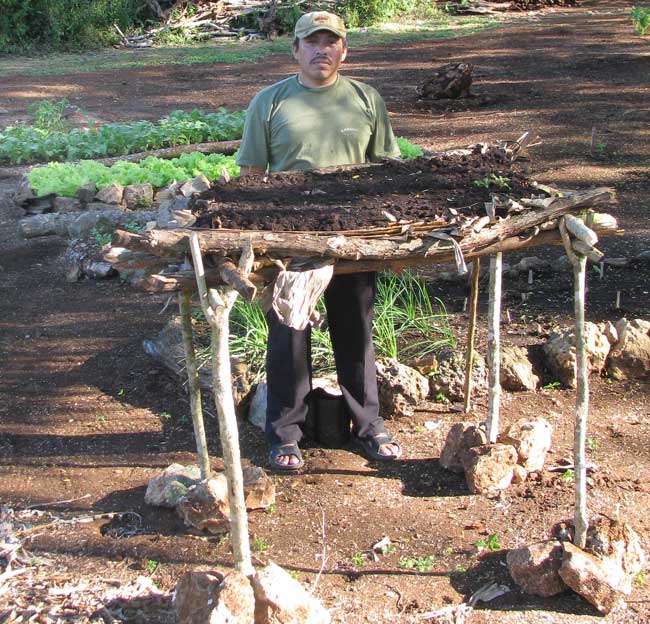Excerpts from Jim Conrad's
Naturalist Newsletter

from the November 21, 2010 Newsletter issued from Hacienda Chichen Resort beside Chichén Itzá Ruins, central Yucatán, MÉXICO; limestone bedrock, elevation ~39m (~128ft), ~N20.676°, ~W88.569°
WILFRIDO'S GARDEN CANCHÉ
Luis the gardener quit, so now we have a new gardener, Wilfrido. That's him next to his new canché above. Like Luis, Wilfrido tends his own family milpa, or traditional cornfield, and he knows everything the typical Maya farmer knows about how to grow things, which is a lot. As soon as Wilfrido arrived and got most Pica-Pica vines cleared from the main garden area he set to work building his canché.
The beds behind Wilfrido, in Maya called eras, grow healthy crops of radishes, leaf lettuce, cilantro, garlic and, to the right of the garlic, lemongrass. Both the eras and the canché accomplish the goal of gathering soil in one place so that it's thick enough to be worked and to support plants. In the Yucatán this is often necessary because in many places the soil is exceedingly thin atop the limestone bedrock and so poor in organic matter that it dries out fast. The thinness isn't entirely the result of erosion caused by frequent deforestation. Friar Diego de Landa in his manuscript of 1566 Relación de las cosas de Yucatán writes:
Yucatán is a land of less soil than any I know, being all live flat stones with very little earth, so that there are few places where one can dig down a {unit of measure} without meeting great banks of large rocks.
The canché has the advantage over the beds on the ground in that it's harder for animals to get at the plants. You've heard about our animal depredations. The newest one is that someone, probably a Coati, dug up a cantaloupe-size jícama tuber, or yam-bean, and ate the whole thing, killing the sizable vine that had sprouted from it.
Wilfrido's canché is composed of an elevated bed of poles atop which banana leaves are placed thickly enough to hold the soil deposited atop it. It's not absolutely animal-proof, but it's a little more so than a bed on the ground.